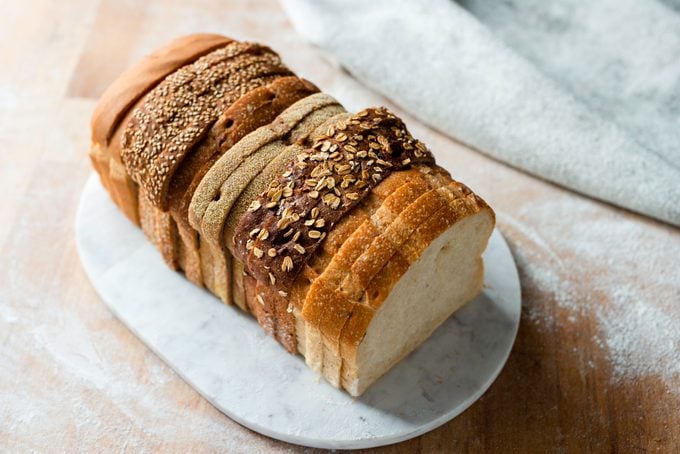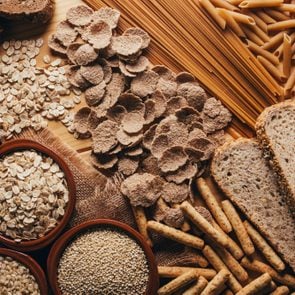What Is the Healthiest Bread?
Updated: Jun. 02, 2021
Yes, there is such a thing as healthy bread. Registered dietitians share their favorite types plus the healthiest bread brands at the store.
Our editors and experts handpick every product we feature. We may earn a commission from your purchases.
Why does bread have a bad reputation?
You wouldn’t know it from all the recent sourdough bread-baking, but bread is considered the enemy in certain low-carb quarters. Its “unhealthy” reputation stems from the low-carb diet myth that all carbohydrates are inherently bad. Although it’s true that heavily processed, refined carbohydrates and sugary foods lack nutrients, not all types of carbs or bread fall into this category, says Malina Malkani, RDN, a registered dietitian nutritionist in Westchester, New York. It’s possible for bread to be part of a healthy diet.
In fact, depending on the loaf, bread can be packed with nutrients. Whole grain bread, for instance, is a good source of B vitamins, including folic acid, iron, magnesium, selenium, and dietary fiber, according to the American Heart Association.
Another common belief about bread is that it causes weight gain. Research in the Journal of Nutrition, however, found that weight gain—and increases in abdominal fat over time—is lower in people who consume more whole grain foods such as whole grain bread.
Trust only the ingredient and nutrition labels
One thing that Lisa DeFazio, RDN, a registered dietitian nutritionist in Los Angeles, looks for is whole wheat or whole oats as the first ingredient on the list. “Be careful,” she says. “Wheat bread or multi-grain is not always a whole grain product.” That’s why it’s important to look at the ingredients list instead of whatever the brand packaging says. (Here’s the real difference between whole grain and whole wheat.)
Look for a short list of recognizable or pronounceable ingredients, Malkani recommends. Again, check that whole grains or sprouted flours are the first ingredients because the list is in descending order of predominance by weight.
Next, check out the nutrition label. The healthiest breads are higher in protein (about 3 to 6 grams per slice) and fiber (roughly 3 to 5 grams per slice) and lower in added sugar (less than 4 grams per slice), Malkani says.
Don’t buy bread based on its color
When buying healthy bread, keep in mind: The color of the bread is almost meaningless. Sure, whole grain bread is darker than white bread. But manufacturers may add food coloring to give their processed bread a darker appearance and trick nutrition-savvy shoppers who want healthy wheat bread, according to DeFazio. Again, make sure to check the ingredients label.
The healthiest bread brands
DeFazio and Malkani have a few favorite healthy bread brands. Those include: Food for Life Ezekiel Sprouted Whole Grain Breads, Dave’s Killer Breads, Trader Joe’s Whole Wheat Sourdough, Alvarado Street Bakery, Angelic Bakehouse, Vermont Bread Company, and Franz Bakery.
Healthy types of bread
100 percent whole wheat
Whole wheat is the first type of healthy bread that typically comes to mind. The flour used to make 100 percent whole wheat bread is less processed and retains both the bran and germ of the wheat grain, according to Malkani. Whole grains, including whole wheat, have been linked to a range of health benefits, including decreased risk for type 2 diabetes, heart disease, and weight gain, according to the review of studies in the Journal of Nutrition.
Sprouted whole grain
Sprouted bread is made from whole grains that have sprouted from exposure to heat and moisture, says DeFazio. This process increases the grains’ antioxidants. Malkani adds that the sprouted grains in sprouted grain bread have a higher enzyme content, too. (Read about foods high in antioxidants.)
According to Critical Reviews in Food Science and Nutrition, these grains contain more protein and more bioavailable, high-quality nutrients than other grains, and may be easier to digest. Most sprouted breads are high in fiber and protein, per research in the journal Nutrients. So swapping out your white bread for sprouted whole grain is a simple way to get more fiber in your diet.
The benefits of sprouted whole grain bread may also extend to weight loss due to its lower carb count. According to a study in the Journal of Nutrition and Metabolism, sprouted grain bread has fewer carbs, with 34 grams in a four-ounce serving, compared to 44 grams in 12-grain bread.
The sprouting process allows the grains to absorb more water, lowering the carb content. “Sprouting breaks down the starch in grains and reduces the carb content,” DeFazio says. As a result, “sprouted grains do not spike blood sugar like white bread.”
(Check out this recipe for cloud bread, a no-carb bread option.)
Whole wheat sourdough
This bread is easier to digest than others, thanks to the prebiotics and probiotics created during the fermentation process, according to DeFazio. The fermentation process that’s used to make whole wheat sourdough bread helps reduce the number of phytates that bind to certain minerals and impair their absorption in the body, according to a study in the Journal of Agricultural and Food Chemistry. As a result, Malkani says that whole wheat sourdough bread is digested more slowly in the body, helping stabilize post-meal blood sugar levels.
Flax bread
Flax bread uses whole grain flours and flaxseeds, according to DeFazio. “Flax bread contains omega-3 fatty acids that are good for heart health,” she says. Bread made with flaxseeds is an especially great bread option for vegans who need more healthy fatty acids in their diet.
These superseeds are also a good source of fiber, protein, and antioxidants. One study in the Journal of Food Science and Technology found that eating flaxseed bread and other flax foods may benefit digestion-related health issues.
Sprouted rye bread
Rye looks like wheat bread, but is darker and denser. Research in Nutrition Journal found that rye may be healthier in terms of making you feel fuller while not affecting blood sugar. Much like sprouted whole grain bread, sprouted rye is a good source of fiber, especially in comparison to regular rye bread. “Sprouted rye bread is high in soluble fiber, which slows your digestion of carbs and decreases the insulin response,” DeFazio says.
Oat bread
One of the newest types of healthy bread on the grocery store scene is oat bread, which includes both oats and whole wheat flour as the primary ingredients. If cauliflower can turn into a pizza, then your favorite breakfast food can absolutely turn into bread.
The best part is that there are already plenty of benefits of eating oatmeal. Oats are high in nutrients like magnesium, zinc, and iron. Plus, the high fiber content may help lower cholesterol levels and decrease high blood pressure, according to research in the American Journal of Clinical Nutrition and Vascular Health and Risk Management.
Gluten-free bread
Gluten-free bread doesn’t have grains like wheat, rye, or barley, according to DeFazio. Instead, gluten-free bread is a mix of gluten-free flours such as brown rice, almond, coconut, tapioca, potato, or corn flours. Gluten-free bread is good for people who need to avoid gluten, like those with signs of celiac disease or gluten sensitivity.
When manufacturers remove gluten, they add other ingredients to compensate because they need the bread to be chewy and have texture, DeFazio explains. So gluten-free bread often has refined flours, added sugars, gums, and tapioca starch that can cause gas, bloating, diarrhea, and gastrointestinal issues.
DeFazio urges those without celiac and or gluten allergies to opt for regular bread. Some people without these health issues mistakenly think if they avoid gluten, they will lose weight, she says. Keep in mind that avoiding gluten will not automatically result in weight loss, nor is it necessarily healthier than other types of bread.
Bottom line: What’s the healthiest type of bread?
Bread is not the enemy. “Find a bread you enjoy that is also healthy,” suggests DeFazio. If you hate the taste and texture of one type of bread, move on and find another.
The healthiest bread option for you really depends on a few factors. Bread made with 100 percent whole grains is less processed and offers more health-promoting nutrients per calorie than bread made with refined flours. That alone makes it the best healthy bread option for most people, according to Malkani. Sprouted grain bread and whole grain sourdough are good choices for those with digestive concerns, she adds.
Look for bread that features whole grains and is high in fiber, but low in sugar. If you use the tips from Malkani and Defazio and choose a loaf from one of the healthiest bread brands, you’ll make a foolproof, tasty choice every time.





















